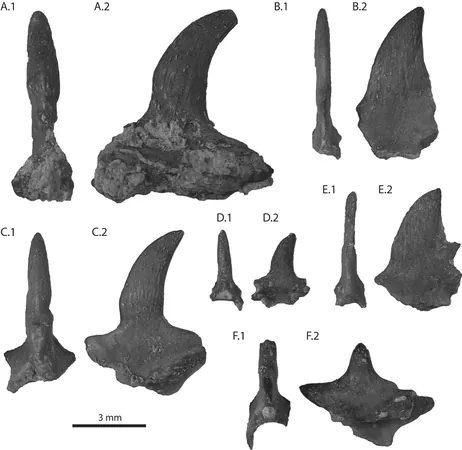
Unveiling the Secrets of Triassic Tanystropheids: A Groundbreaking Discovery in Arizona
2025-08-17
Author: Benjamin
Extraordinary Discoveries in the Petrified Forest
A team of researchers has uncovered a treasure trove of three distinct tanystropheid taxa in Arizona's Petrified Forest National Park, specifically from the upper Blue Mesa Member of the Chinle Formation. Among these finds is a brand-new genus and species, named Akidostropheus oligos, distinguished by an intriguing back spike emerging from its spine.
The Emergence of Archosaurs
The story of archosauromorph reptiles begins in the Permian era. These creatures flourished in the wake of the end-Permian extinction, leading to their domination in the Triassic period. This diverse group includes crocodilians, nonavian dinosaurs, and possibly turtles, revealing a rich evolutionary tapestry.
Unlocking the Past: Tanystropheids and Their Ecological Secrets
Tanystropheids are a fascinating subset of archosauromorphs, showcasing remarkable diversity in body plans and habitats. They thrived in both marine environments and freshwater ecosystems, leaving behind a growing fossil record across North America during the Triassic.
A Study of Diversity and Anatomy
In their insightful study, published in Palaeodiversity, the researchers examined the anatomy of cervical vertebrae to identify diversity among these taxa. Their meticulous work recognized three unique taxa at the site, including the notable Akidostropheus oligos, characterized by its unique dorsal spike, potentially serving as a defense mechanism.
The Search for Fossils: A Labor of Love
The team undertook painstaking paleontological procedures to collect fossils, employing techniques like hand quarrying and screen washing. Although the bones found were often disarticulated, the cervical vertebrae provided key insights, measuring just 6.7 mm tall and 5.5 mm long.
Diverse Morphotypes Revealed
Interestingly, one or perhaps two unidentified taxa exhibited two distinct morphotypes. The first type displayed moderately elongated neck bones, while the second showcased very elongated neck bones with unique characteristics. The aff. Tanystropheus had ultra-elongated neck bones, suggesting evolutionary advancements.
Significance of Akidostropheus Oligos
Akidostropheus oligos is particularly fascinating, with tiny vertebrae and a distinctive back spike adorned with fine striations, suggesting it could feature a keratinous sheath. This adaptation may have served as armor against predators, offering a glimpse into the survival strategies of Triassic vertebrates.
Insights into Triassic Ecosystems
The unexpected diversity among tanystropheid archosauromorphs hints at thriving semi-tropical nonmarine ecosystems, providing ample opportunity for species development and ecological niche partitioning during the Triassic era. This find enriches our understanding of a group typically represented in two-dimensional fossil records, revealing dynamic life forms once roamed the Earth.
A New Chapter in Paleontology
As研究者s continue to unearth these ancient secrets, the discovery of Akidostropheus oligos and its kin not only adds to our understanding of the past but also opens new avenues for exploring the evolutionary history of life on land.









 Brasil (PT)
Brasil (PT)
 Canada (EN)
Canada (EN)
 Chile (ES)
Chile (ES)
 Česko (CS)
Česko (CS)
 대한민국 (KO)
대한민국 (KO)
 España (ES)
España (ES)
 France (FR)
France (FR)
 Hong Kong (EN)
Hong Kong (EN)
 Italia (IT)
Italia (IT)
 日本 (JA)
日本 (JA)
 Magyarország (HU)
Magyarország (HU)
 Norge (NO)
Norge (NO)
 Polska (PL)
Polska (PL)
 Schweiz (DE)
Schweiz (DE)
 Singapore (EN)
Singapore (EN)
 Sverige (SV)
Sverige (SV)
 Suomi (FI)
Suomi (FI)
 Türkiye (TR)
Türkiye (TR)
 الإمارات العربية المتحدة (AR)
الإمارات العربية المتحدة (AR)